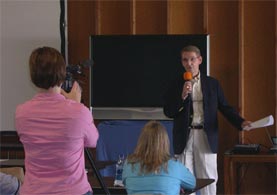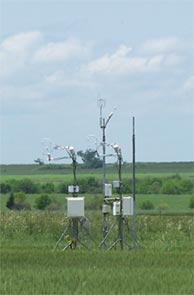CLASIC Hits the Dirt—and the Air—in Oklahoma
Published: 15 June 2007

On June 11, media and distinguished guests were invited to a media day in Ponca City, Oklahoma, to learn about the CLASIC and CHAPS field campaigns taking place in the region. In addition to the media, former Oklahoma State Senator Paul Muegge and current State Senator David Myers attended, as did Dr. Ken Crawford, the state climatologist for Oklahoma and “father of the Oklahoma Mesonet.” The event began with an introduction from special guest Dr. Jerry Elwood, Director of DOE’s Climate Change Research Division. His opening was followed by science overviews from Mark Miller, principal investigator for CLASIC, and Carl Berkowitz, principal investigator for CHAPS.
The event’s morning activities were held at the Ponca City Airport, headquarters for mission planning and the primary field base for six of the nine participating aircraft during the campaigns. In the afternoon, attendees were invited to visit the ARM Southern Great Plains site’s Central Facility, about 45 minutes from Ponca City. They were treated to a guided tour of the various instruments and operations activities around the Central Facility, one of the primary surface sites for the “land” portion of CLASIC.

The weeks leading up the start of the campaign were a flurry of activity. Except for the Cessna 206, whose home base is in Ponca City, instrument integration, weight and balance, and test flights of the other aircraft were completed at their various bases of operations. Throughout the SGP site, scientists began arriving to install their instruments, additional carbon/eddy flux towers were set up, and university students were given training by ARM operations personnel for the supplemental weather balloon launches that will occur during the campaign.
The ARM Climate Research Facility is a DOE Office of Science user facility. The ARM Facility is operated by nine DOE national laboratories, including .
Keep up with the Atmospheric Observer
Updates on ARM news, events, and opportunities delivered to your inbox
ARM User Profile
ARM welcomes users from all institutions and nations. A free ARM user account is needed to access ARM data.


















